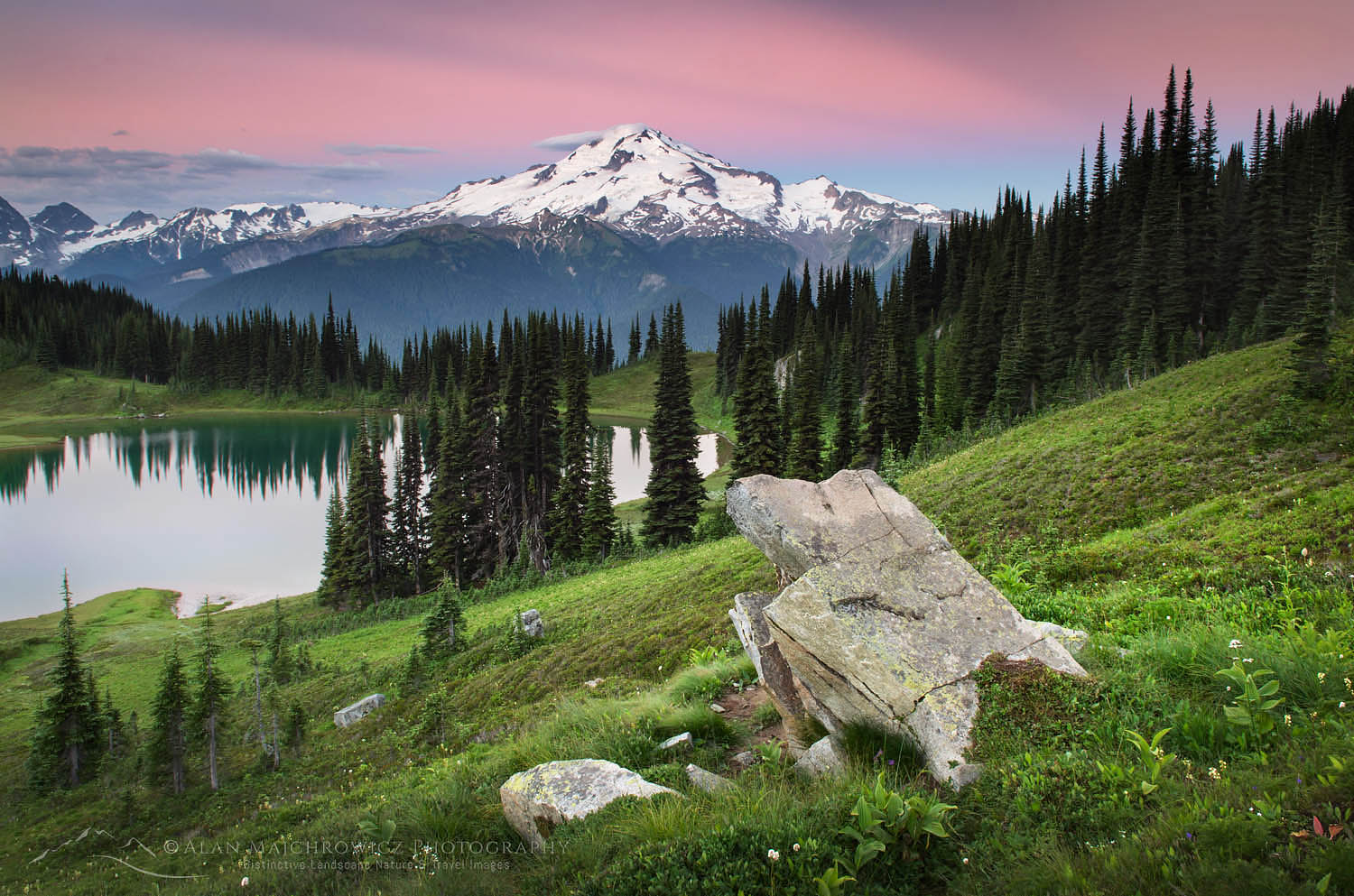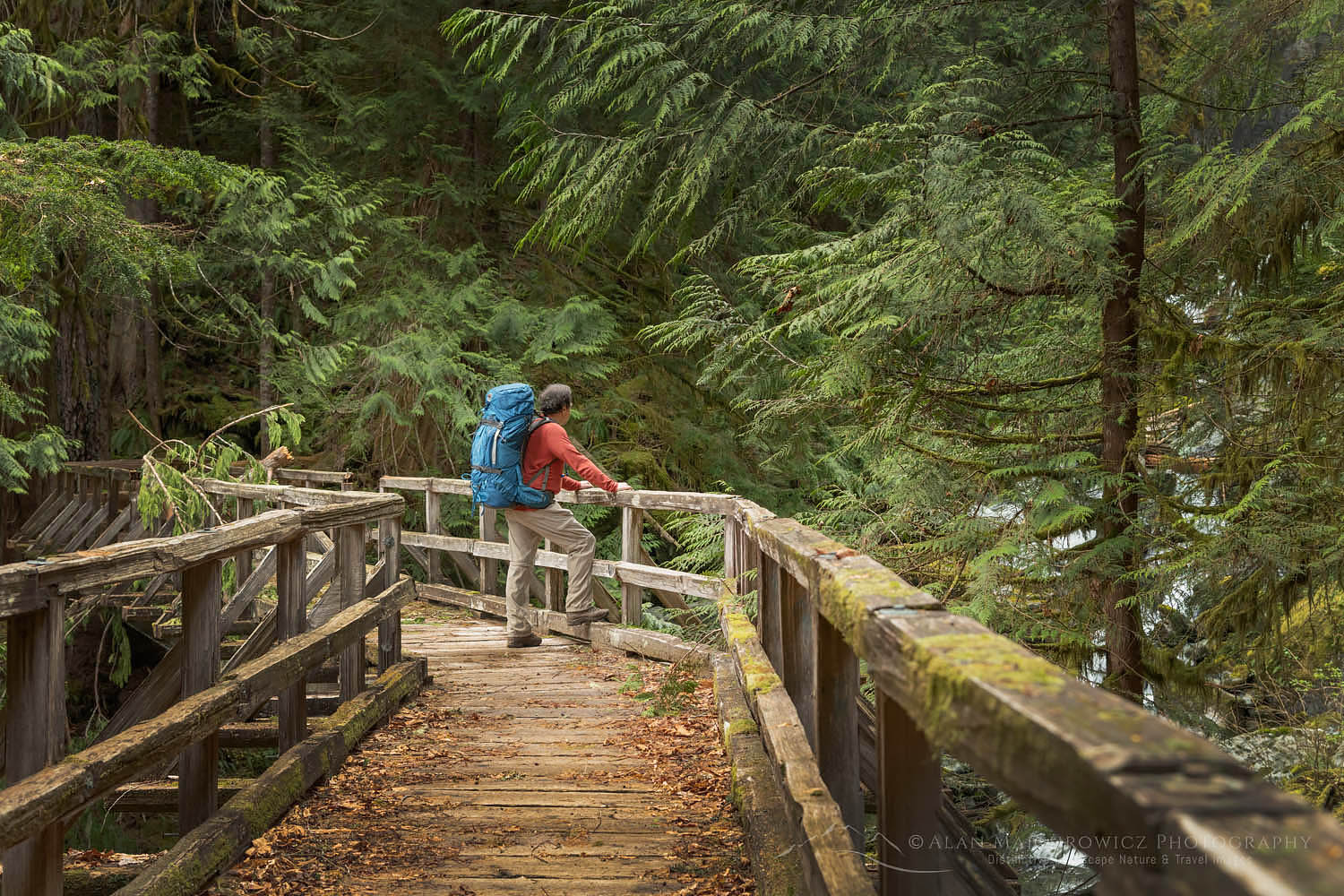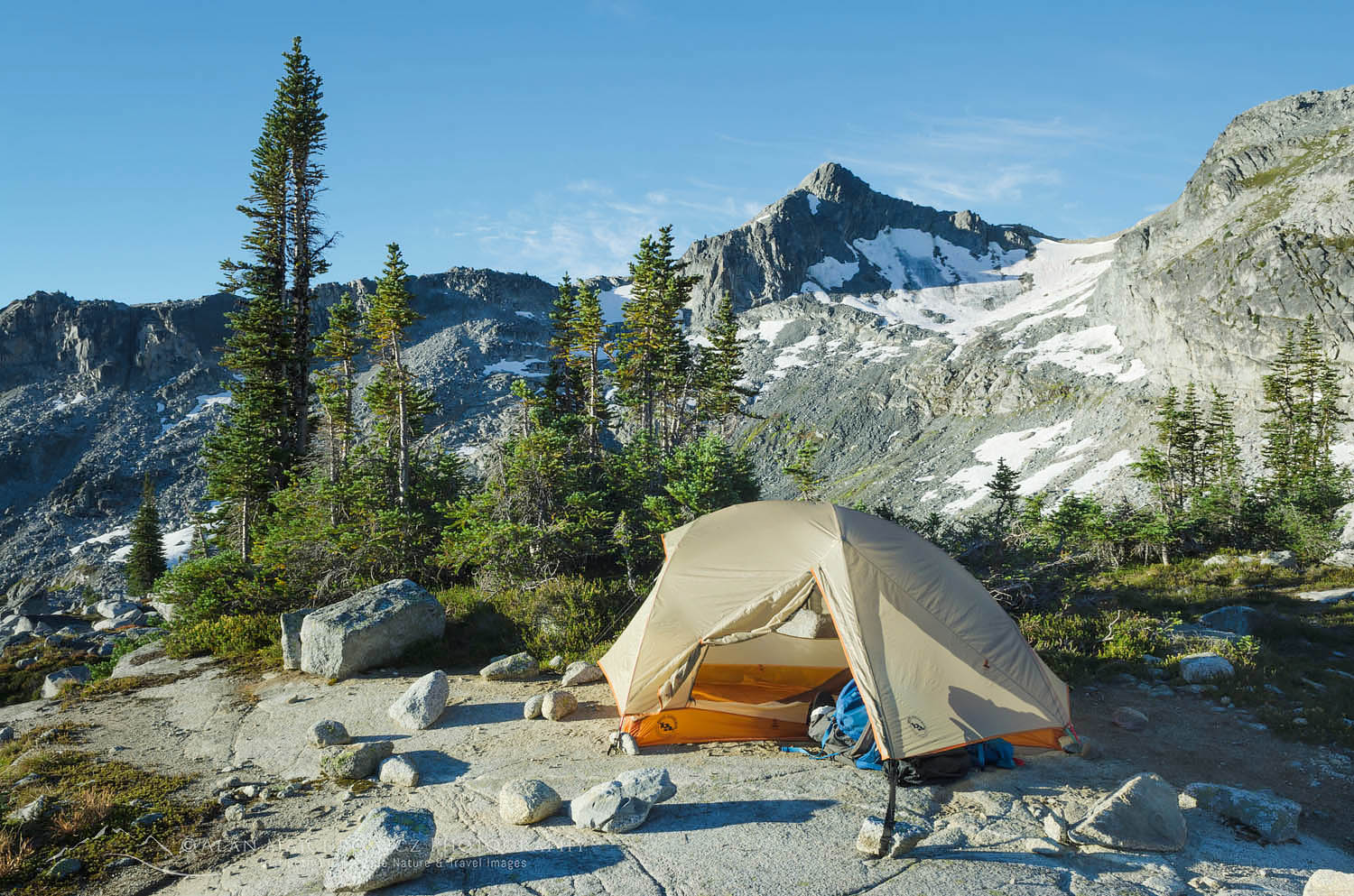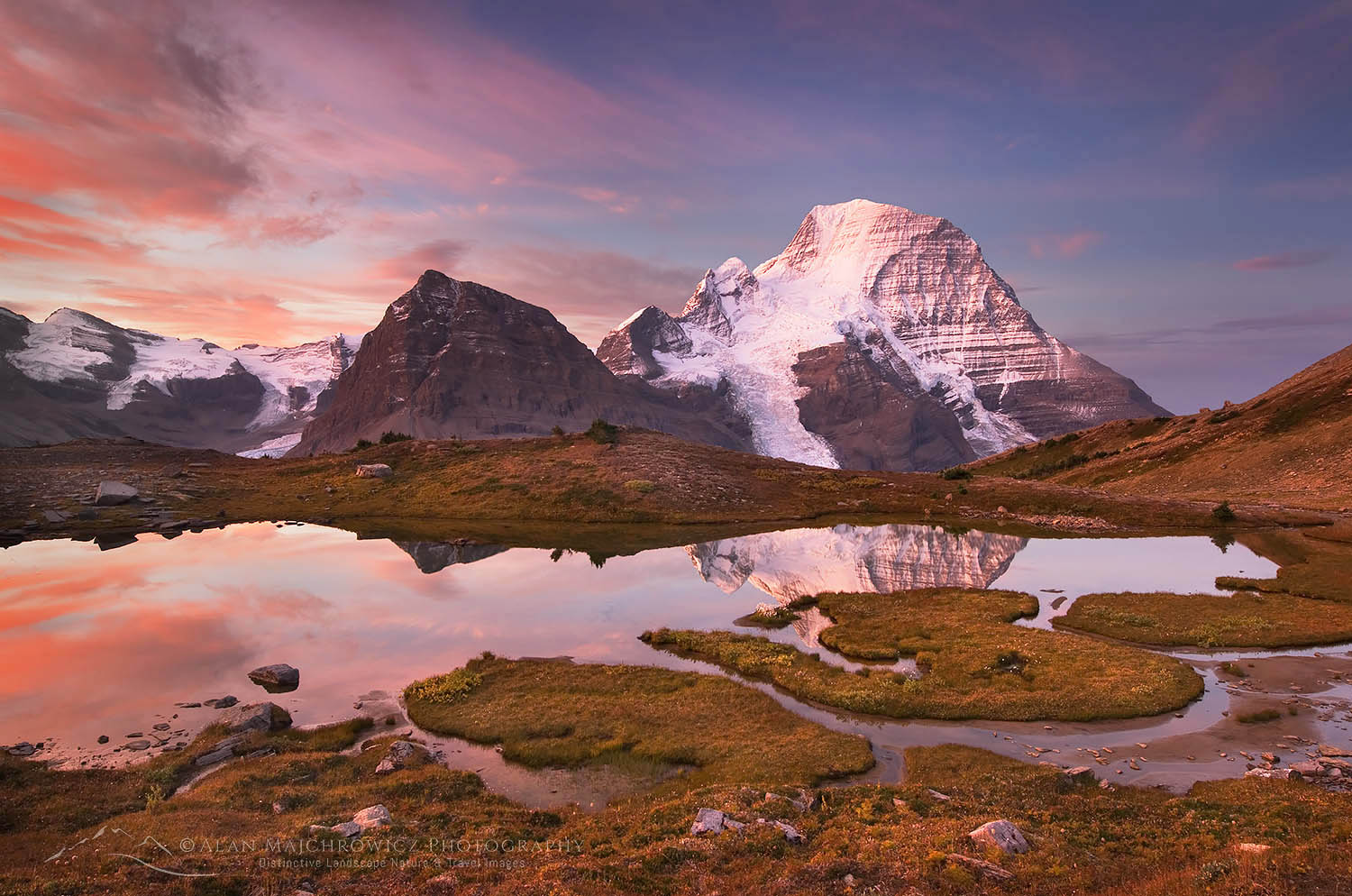Backpacking Photography Tips
 Mount Baker Wilderness North Cascades #54316r Purchase
Mount Baker Wilderness North Cascades #54316r Purchase
Photography has always been an essential element of vacations. Since the first portable roll film camera was introduced people have been taking pictures of their travels. And backpacking trips into wilderness areas are certainly no exception. In this post, I’ll be offering some backpacking photography tips to help make your trip a success.
My previous post, Backpacking Photography Gear Tips, went into some of the details of choosing the proper photography and backpacking equipment. This time I’ll give tips on photography while backpacking on the trail.
For the purpose of this post, I’ll focus on some basic tips for working in the field which can help to free your creativity.
 Mount Robson British Columbia #54646 Purchase
Mount Robson British Columbia #54646 Purchase
Set a Goal
Setting a goal for yourself can vastly help in making better photographs. These goals can vary depending on a number of factors, such as:
- Location
- Season
- Weather
- Subject matter
- Time available
- Physical condition
On a backpacking trip you may need to place a limit on and be flexible with your goals. For example, if your goal is action/adventure photography your opportunities for landscape or nature photography will be limited. Or if your goal is to photograph dramatic landscapes but the weather is consistently gray, consider changing your goal to nature details and or abstracts.
 Backpacking in the Wind River Range #66330 Purchase
Backpacking in the Wind River Range #66330 Purchase
Know Your Limits
Remember that your pack will most likely be fairly heavy, and will determine how far and fast you can travel. Don’t push yourself beyond your limit. Take it easy and break your hiking distances into manageable lengths. If you arrive at camp physically exhausted you won’t have much energy left to making good photographs. Unless the perfect image is right in front of your tent you’ll need to be on the move until after sunset.
Carefully research your trip in advance. Check out trip reports and maps, and pay particular attention to elevation differences from point to point. You may think that you can easily hike 15 miles in a day. However, that distance will be considerably less when you throw in 3000′-4000′ elevation gain while carrying a full pack.
Also, know your location. Backpacking in Wyoming’s Wind River Range is vastly different from backpacking in the North Cascades. In the Winds, you gain elevation gradually with many ups and downs. In the North Cascades, large amounts of elevation are gained either by endless switchbacks or straight-up endurance tests.
 Glacier Peak and Image Lake North Cascades #58239 Purchase
Glacier Peak and Image Lake North Cascades #58239 Purchase
Know Your Subject Matter
This may be the most important tip I have to offer.
The best portrait photographers will always tell you this. Being keenly aware of, and bringing out the nuances in someone’s personality is the key to great portrait photography. This is also true for other subject matter, including landscape and nature.
One of the best ways of accomplishing this is to just sit and observe, be meditative. Consider the current catchphrase Light And Fast. Going light is good, but why fast, what’s the rush? Isn’t wilderness something to be savored? Aside from photography aren’t you also here to get away from the rush and complexities of daily living?
Slow down and think creatively, you’ll enjoy your trip more and make better images.
It’s easy to backpack into a beautiful area, set up camp, grab your camera and snap your brains out. However, when you get back home you most likely will have only snapshot quality photos.
While on the trail be observant of your surroundings. Take frequent breaks and enjoy the scent of the forest and the sounds of the birds and streams. After setting up camp use this time to relax and restore your physical and mental energy.
Be particularly aware of how the light changes. The position of the sun and the type of light can make the difference between a good and great photo.
See and photograph with your own eyes. Don’t set out armed with GPS coordinates just so you can replicate the other guy’s photo.
Know your subject and photograph deliberately.
 Backcountry Camp Mount Baker Wilderness #53372 Purchase
Backcountry Camp Mount Baker Wilderness #53372 Purchase
Selecting A Campsite
Ideally, you’ll need to select a campsite or base camp on longer trips, that is in close proximity* to your subject matter. If your campsite is a mile or more from that perfect mountain view or field of wildflowers you’ll need to rush to get there in time to set up.
This is especially important at sunrise. It’s incredibly easy to just sleep in if you need to make a long pre-dawn trek to that great composition. Especially if it’s several hundred feet higher up. In a perfect situation, you should have a variety of compositions to photograph within a quarter-mile of camp.
If you’re backpacking in a National Park or Wilderness Area with camping restrictions your options may be limited. National Parks deliberately, and for good reasons, limit camping proximity to pristine locations. Always do your research and check in advance. In these situations, you may have to plan on some extra legwork.
*Whenever possible camp only on hardened established sites, bare ground, rock, or snow. This may not be an option in very remote or rarely visited areas. Scroll down to read about minimal impact and Leave No Trace Principles.
 Backpacker North Cascades #65027 Purchase
Backpacker North Cascades #65027 Purchase
Location Scouting
Good location scouting begins at home while researching your trip. Trip reports and guidebooks usually include photos of the area. Poring over topographic maps can give clues to directions of light, and hidden features. Goggle searches of your trip area using different keywords can also reveal little-known spots.
1. If you planned carefully you should arrive at and set up camp early enough to have time to relax and do some scouting. Aside from obviously finding the best spots for compositions, scouting also gives you an opportunity to get to know your subject better.
2. Walk through the entire area, and look beyond the obvious. While the big snowcapped mountain may be the obvious dominant element, there may be other compositions more subtle yet just as inspiring. It’s easy to focus your attention on the main scene during golden hour and completely miss something even better in the opposite direction.
3. Be aware of where the sun will rise and set in relation to the landscape. That perfect composition may be in shadow during morning and evening golden hours. This is particularly true in deep narrow valleys.
4. Be observant of cloud and weather patterns. Some mountain ranges are prone to dramatic midday storms. However, at sunset and sunrise, the sky may be devoid of any clouds. Of course, in some areas, the opposite may be true. That gorgeous summit may be consistently shrouded in clouds at sunset.
5. Look for key elements which can you can use in compositions. For a mountain scene, a foreground with a winding stream or a grouping of wildflowers can add movement and depth to the image. Objects such as boulders, a distant tent, or a person can also add scale to the scene.
 Limestone Lakes British Columbia #46236 Purchase
Limestone Lakes British Columbia #46236 Purchase
Commit to Photographing
Face it, backpacking and the related chores of camping are a lot of work. But it’s only one-half of the work you’ll face when you’re there to make excellent images. While other parties are sitting around camp enjoying the sunset, or sleeping late the next morning, you need to be on the move.
1. Don’t be in a rush, plan in extra days. Good light and photography rarely happen on your schedule. An extra day or two in an area increases your chance of getting the light you want.
2. Get accustomed to rising before dawn in the morning. How early you need to get up depends on how far you are from where you need to photograph. You can always get more sleep when you return to camp.
3. Stick it out until it’s really over. Some photographers pack it up right after the sun sets or rises. Big mistake. I can’t tell you how many times it appeared like all the best light was gone, only for the sun to find a gap in the clouds and come back in full force. Sometimes you’ll be faced with a boring cloudless sunrise when a few minutes later glowing wisps or puffy clouds develop literally out of nowhere.
4. Wait for the afterglow. Often, hidden beyond your view, there may be some atmospheric elements that create a beautiful long-lasting afterglow.
5. If the sky is clear of clouds and there is no afterglow it’s always worth waiting to photograph the Belt of Venus and during the blue hour.
6. Stay up late or wake up earlier for photographing the Milky Way.
7. With the right conditions excellent images can be made throughout the day, not just during golden hours. Always keep your mind and eyes open to new creative opportunities.
8. Wait out the weather. You’ve put a lot of time and energy into getting here. Stick it out if you can.
 Glacier Peak Wilderness #58315 Purchase
Glacier Peak Wilderness #58315 Purchase
Eat Well and Smart
Good nutrition is important to maintain the energy you need to sustain a high level of activity. There are endless books, articles, and opinions available to help guide you and confuse you on this topic. Everybody is an expert and will be happy to point out why their research is right and yours is wrong.
I’m not a nutrition expert but I have found out through experience what works for me and what doesn’t. Everybody is different. You’ll need to find a balance of taste, convenience, and nutrition that works for you, preferably in advance of a long trip.
1. Whatever choice of food make sure you bring enough. You’ll be burning a lot more calories per day than you normally would.
2. Keep your menu as simple as possible, and look for dehydrated or freeze-dried items to keep the weight down.
3. For safety in bear country avoid foods with strong odors. Only prepare as much as you can eat, leftovers attract not only bears but also rodents.
4. Try to bring items that can be prepared by just adding boiling water. The time you save can be spent photographing. You’ll also save weight on fuel.
5. When on the trail stay well hydrated, and drink an electrolyte replacement instead of plain water. Over the years I’ve tried many, most taste horrible and are ridiculously expensive. I’ve gone back to Gatorade, it tastes better, is cheap, and works for me.
6. Bring enough energy bars (again, most taste horrible) or trail mix to last the duration of your trip. It’s also a good idea to pack a few special treats to break up the monotony.
7. Supplements are optional and subjective. I always take a B Complex supplement daily. I find it helps in converting nutrients into energy, but that’s just my opinion.
 Coast Mountains British Columbia #61795 Purchase
Coast Mountains British Columbia #61795 Purchase
Leave No Trace
I’ve recently started to add this extremely important topic to all of my hiking posts. Don’t even think about visiting backcountry areas unless you are prepared to strictly follow the guidelines of Leave No Trace (LNT).
All national parks and wilderness areas throughout the world are under incredible pressure from growing amounts of visitors. Please do your part to help preserve these precious areas for future generations!
To learn more about the principles and practicing LNT please take a few minutes to visit the Leave No Trace Center for Outdoor Ethics. Your children and grandchildren will thank you!
Seven Leave No Trace Principles
- Plan ahead and prepare.
- Travel and camp on durable surfaces.
- Dispose of waste properly.
- Leave what you find.
- Minimize campfire impacts (be careful with fire), better yet don’t build one in the first place, they are completely unnecessary.
- Respect wildlife.
- Be considerate of other visitors.
Now that you have some basic understanding of working in the field, get out there and have some fun!
Also, check out these blog posts for hiking and backpacking and photography destinations:
Mount Baker Wilderness Destinations
Hannegan Peak Ruth Mountain Mount Baker Wilderness
Lake Ann Ptarmigan Ridge Mount Baker Wilderness
Coyote Gulch Backpacking Photography
If you found reading Backpacking Photography Tips to be enjoyable and informative please feel free to share it with friends and family
Ever wonder what it’s like photographing landscapes and nature for a living? Check out my blog post:
What is it like to be a Professional Landscape Photographer?
All photos appearing in Backpacking Photography Tips are available for Commercial Licensing and Fine Art Prints
Want to learn more? Take your Creative Photography to the next level with Private Instruction and Guided Photo Tours.
 Mount Robson British Columbia #54618 Purchase
Mount Robson British Columbia #54618 Purchase
Backpacking Photography Tips

Enjoyed the article very much.
Each time I travel, I utilize my Fujifilm XF 18-55mm focal point since it’s compact and lightweight, so it’s anything but difficult to convey and doesn’t take a lot of room in my camera sack. I generally get sharp photographs with this long range focal point, and it permits me to shoot an assortment of subjects like scenes, cityscapes, untamed life, and individuals.
Thanks for your input Zubida.
Thank you very much for sharing all this. I’ve really enjoyed it. I wish I had read it a few years ago because it would have saved me from having to figure it all out by myself over the last few years. Your statements confirm everything I have learned thus far. It’s all very good advice. I also really appreciate that you place an emphasis on caring for the environment, as I have also noticed significant damage done in a short space of time due to tourists trampling our World Heritage Areas here in Tasmania.
These backpacking photography tips are fantastic! I love the emphasis on setting goals and truly knowing your subject—it’s such a great reminder to slow down and savor the experience. The advice on choosing a campsite near your subject is invaluable; nothing beats being able to capture those early morning golden hours without a long trek! Also, the Leave No Trace principles are so important—let’s protect these beautiful places for future generations! Thanks for sharing such insightful guidance!
PhotoFixal
Thanks Bisti, I’m glad you found my post helpful!